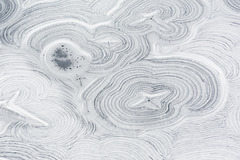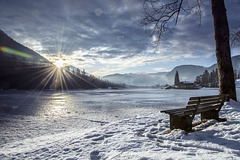
Seen / lakes
Dawn at the Bavarian Sea
| |
|
|
|
The Bavarian Sea (Germany), five minutes before sunrise.
~~~~~
Der Chiemsee (Bayern) in der Morgendämmerung, fünf Minuten vor Sonnenaufgang
Sonnenaufgang am Chiemsee
| |
|
|
|
Sonnenaufgang am Chiemsee am 05. April 2016, einem Tag, an dem verwehter Saharastaub die Luft milchig trüb sein ließ.
Der Ornithologe
2.216 miles from Zagora *)
| |
|
|
|
I didn'd really investigate, whether the sandsturm, which masked the sun that morning, had been blastering over Zagora (Southern Morocco). But while capturing this sun rise over the Chiemsee (Bavaria, Germany) I remembered a desert tour on dromedars in South Morocco, where I experienced a sandstorm life.
Also look here: www.3sat.de/mediathek/?mode=play&obj=63390 (minute 4-5)
~~~~~
Ob der Sandsturm, der an jenem Morgen die Sonne verschleierte, über Zagora (südliches Marokko) tobte, hab ich nicht recherchiert. Aber beim Fotografieren dieses Sonnenaufgangs am Chiemsee (Bayern) hab ich an eine Wüstentour in der Gegend denken müssen, wo ich einen Sandsturm life erlebte.
*) www.entfernungvon.com (MUC-OZZ)
~~~~~
How it looks at the place, where it happens:
Sonnenaufgang am Chiemsee
| |
|
|
|
Sunrise at Bavarian See (Bavaria, Germany). The sun was veiled by Sahara dust on that morning brought by the south wind.
~~~~~
Sonnenaufgang am Chiemsee (Bayern). Die Sonne war an jenem Morgen von Saharastaub verschleiert, den der Südwind heranbrachte.
Quietude
| |
|
|
|
Quietude at the Bavarian Sea (Germany) at Holy Night 2015.
Even the water birds respect the stillness.
~~~~~
Friedlich ruht der Chiemsee (Bayern) am Heiligen Abend 2015.
Selbst die Wasservögel respektieren die Stille.
~~~~~
The circle begins to close gradually.
Here my very fist picture on Ipernity:
Dawn at the Bavarian Sea
Lake 'Reintal'
| |
|
|
|
View from the via ferrata Reintaler See near Kramsach (Tyrol, Austria) at all the lakes below the rock face: the large lake Reintaler See in the middle, to the right of it a little lower the lake Krummsee and the lake Buchsee , and even further to the right - very small - the lake Frauensee .
At the bottom of the valley, the river Inn flows from right to left passing Kufstein on its way to Germany. Diagonally to the right in the valley is the village of Kramsach .
~~~~~
Blick aus dem Klettersteig Reintaler See bei Kramsach (Tirol, Österreich) auf alle Seen unterhalb der Felswand: Der große Reintaler See in der Mitte, rechts davon etwas tiefer der Krummsee und der Buchsee , sowie noch weiter rechts - ganz klein - der Frauensee .
Hinten im Tal fließt der Inn von rechts nach links an Kufstein vorbei nach Deutschland. Schräg rechts im Tal der Ort Kramsach .
~~~~~
Silvretta Stausee
| |
|
|
|
Blick auf den Silvretta Stausee (Vorarlberg, Österreich). Im Hintergrund das Silvrettahorn, und ganz links der kleine Piz Buin über dem Ochsentaler Gletscher.
Piz Buin
| |
|
|
|
Mit 3.312m Höhe ist der große Piz Buin der dritthöchste Berg des Silvretta-Hauptkammes und der höchste Berg des österreichischen Bundeslandes Vorarlberg. Über seinen Gipfel verläuft die Grenze zwischen Österreich und der Schweiz.
Der Gipfel des großen Piz Buin (linker Gipfel) war während der Fotoaufnahmen ständig von einer Wolke umhüllt. Der kleine Piz Buin (3.255m) ist vollständig zu sehen. Unterhalb der Gipfel liegt der Ochsentaler Gletscher.
Rechts im Hintergrund das Silvrettahorn.
(Blick vom gegenüberliegenden Ufer des Silvretta-Stausees im Licht der Spätnachmittagssonne.)
Der Achensee
| |
|
|
|
The Achensee in North Tyrol (Karwendelgebirge, Austria).
(View to the north)
~~~~~
Der Achensee in Nordtirol (Karwendelgebirge, Österreich).
(Blick nach Norden)
Paraglider über dem Achensee
| |
|
|
|
Paraglider over the lake Achensee , a popular holiday destination in the Northern Alps, captured from the summit of the Bärenkopf (1,991m) in the Karwendel Mountains (Tyrol, Austria).
~~~~~
Paraglider über dem Achensee , einer beliebten Urlaubsdestination in den Nordalpen, aufgenommen vom Gipfel des Bärenkopf (1.991m) im Karwendelgebirge (Tirol, Österreich).
Dancing With Clouds
| |
|
|
|
Aerial capture out of a hot-air balloon crossing the lake 'Walchsee' (Tyrol, Austria).
Luftaufnahme aus einem Heißluftballon über dem Walchsee (Tirol, Österreich).
~~~~~
Aerial photo while ballooning near Walchsee (Tyrol, Austria), January 2016.
Lake WALCHSEE
| |
|
|
|
Seldom to be seen from that angel of view. Even more seldom with such a lack of snow on the surface of the frozen lake, because in last winter we had only few snowfalls in Tyrol until end of January.
(Aerial capture out of a hot-air balloon crossing the lake 'Walchsee' (Tyrol, Austria).)
~~~~~
Selten zu sehen aus dieser Perspektive - und noch seltener mit so wenig Schnee auf dem Eis. Denn es hatte im vergangenen Winter bis Ende Januar extrem wenig geschneit.
(Luftaufnahme aus einem Heißluftballon über dem Walchsee (Tirol, Österreich).)
~~~~~
Aerial photo while ballooning near Walchsee (Tyrol, Austria), January 2016.
From a greater distance:
Disclosing the secrets of the structures:
Ice Circles
| |
|
|
|
I never saw those structures before.
The reason is exciting:
3. With regard to the lake Walchsee it means: The water of this lake is heavily contaminated with dead organic particles, which are washed in by the tributary waters. As time goes by they sink to the bottom of the lake, forming a layer of dead organic material there. Step by step this material decomposites and forms marsh gas. (This phenomenon is well known. You may watch it at lakes or pools in forests.) The gas rises in bubbles. But within the Walchsee they only have 21 meters of altitude to ascend. Therefore they stay less than bubbles within the lake Baikal, which has a depth of 1.600 meterns. That's the reason why the ice circles on the Walchsee are smaller.
~~~~~
Ich hab nie zuvor solche Eisstrukturen gesehen.
Die Erklärung ist erstaunlich:
3. übertragen auf den Walchsee bedeutet das: Das Wasser des Walchsees ist stark mit toten organischen Partikeln belastet, welche durch die Zuflüsse eingetragen werden und im See allmählich auf den Grund sinken. Dort bildet sich eine Schicht aus totem organischen Material, dass sich allmählich zersetzt. (Dieses Phänomen ist bekannt und weit verbreitet. Man kann es in vielen kleinen Waldtümpeln beobachten.) Dabei entsteht sog. Sumpfgas, das in Blasen aufsteigt. Die Gasblasen haben im Walchsee allerdings nur bis zu 21m Aufstiegshöhe. Deshalb bleiben sie kleiner als im Baikalsee mit seinen 1.600 Metern Wassertiefe, wo sich die kleinen Bläschen beim Aufsteigen zu großen Blasen vereinigen können. Die Eiskreise auf dem Walchsee sind deshalb kleiner.
~~~~~~
Aerial photo while ballooning near Walchsee (Tyrol, Austria), January 2016.
Disclosing the secret, part 1:
Disclosing the secret, part 2:
Amazing Structures
| |
|
|
|
I never saw those structures before.
The reason is exciting.
2. This phenomenon is known from elsewhere: The phenomenon of ice circles has bee described in 1882. But it didn't evoke interest of scientists before 1995, when very large ice circles were seen on satellite photographs of lake Baikal with diameters of some kilometers. As recently as 2009 those ice circles were explored. Measurements of temperature and flow underneath the frozen surface uncovered the mystery.
Beneath the ice circles large vortices are stirring. Those circulating waters cause the dark ringlike structures. The vortices originate from ascending methane bubbles, which are developping by decomposing of organic materials at the bottom of the lake. The bubbles take warm waters on their way up. A vertical flow results, which is circling under the influence of the Coriolis force - in the same manner as waters do within the plug hole of an wash-bowl, but reverse.
www.spiegel.de/wissenschaft/natur/a-674932.html
If you know, what you have to be looking for, you'll find some more interesting pictures within the worldwide web:
www.leidorf.de/images/dzoom/grafik/1Ds38720_Eis.jpg
~~~~~
Ich hab nie zuvor solche Eisstrukturen gesehen.
Die Erklärung ist erstaunlich:
2. ist das Phänomen von anderswo bekannt: Das Phänomen der Eiskreise wurde schon 1882 beschrieben, erweckte aber erst 1995 wissenschaftliches Interesse, weil auf Satellitenaufnahmen kilometergroße Eiskreise auf dem Baikalsee entdeckt wurden. Erst 2009 wurden diese Eiskreise genauer erforscht. Temperatur- und Strömungsmessungen unter der Eisoberfläche brachten die Erklärung.
Unter den Eiskreisen bewegen sich Strudel. Das kreisförmig zirkulierende Wasser verursacht die dunklen Ringstrukturen im Eis. Ursache für die Strudel ist aufsteigendes Methangas aus sich zersetzendem Pflanzenmaterial am Boden des Sees. Die Gasblasen nehmen wärmeres Wasser mit hoch. Es entsteht eine Aufwärtsströmung, die sich unter dem Einfluss der Corioliskraft zu drehen beginnt - wie das Wasser im Abfluss eines jeden Waschbeckens, nur umgekehrt herum.
www.spiegel.de/wissenschaft/natur/a-674932.html
Wenn man weiß, wonach man suchen soll, findet man übrigens weitere interessante Aufnahmen:
www.leidorf.de/images/dzoom/grafik/1Ds38720_Eis.jpg
~~~~~
Aerial photo while ballooning near Walchsee (Tyrol, Austria), January 2016.
Disclosing the secret, part 1:
Disclosing the secret, part 3:
Ice-Land
| |
|
|
|
A litttle island within the lake Walchsee.
~~~~~
Eine kleine Insel im Walchsee
~~~~~
Aerial photo while ballooning near Walchsee (Tyrol, Austria), January 2016.
Stillness
| |
|
|
|
Sunrise at the frozen Pillersee (St. Ulrich, Tyrol, Austria)
~~~~~
Sonnenaufgang über dem zugefrorenen Pillersee (St. Ulrich, Tirol, Österreich)
Lago di Toblino
| |
|
|
|
Here from the very top of the fixed rope route 'Che Guevara'.
~~~~~
Der See von ganz oben. (Sieht man ja nicht so oft.)
Jump to top
RSS feed- Latest items - Subscribe to the latest items added to this album
- ipernity © 2007-2024
- Help & Contact
|
Club news
|
About ipernity
|
History |
ipernity Club & Prices |
Guide of good conduct
Donate | Group guidelines | Privacy policy | Terms of use | Statutes | In memoria -
Facebook
Twitter


















